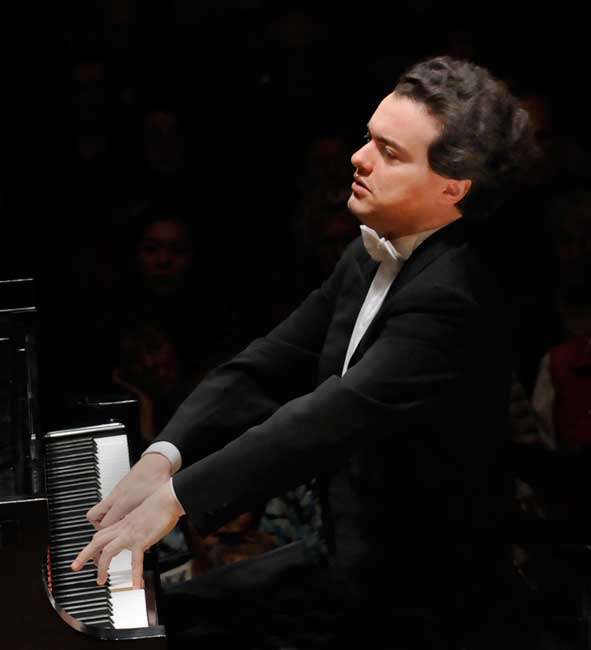Kissin’s singular artistry illuminates Beethoven warhorse, Spanish rarities
At first glance, it was tempting to call Evgeny Kissin’s Tuesday recital program at Carnegie Hall “eclectic,” journeying as it did from Mozart to Larregla. As concertgoers, we’ve become so conditioned to hearing catalogue recitals (all of the Debussy Preludes, for instance), or one-composer recitals, or themed recitals, that to hear a recital that features composers of various eras and styles for no other reason than the taste of the performer feels almost unusual.
But such a curious program reveals something about the artist’s personality, as well, and in this case demonstrated impressive curatorial skill. Far-flung though they may have seemed, Kissin’s selections were superbly selected, complementing each other perfectly, and were beautifully, distinctively played.
The only part of Kissin’s program that was wanting was his Mozart, the Sonata in C Major, K. 330. An overly fussy, even unsteady approach often made it difficult to hear the music’s natural impulse in the first two movements. The Andante cantabile was not really “singing,” Kissin’s extracurricular vocalizing excepted.
These complaints, though, are stylistic rather than interpretive or technical, and much of his Mozart playing was lovely, with pristine balancing, glowing tone, and shapely phrases. The playing on the whole was elegant and sophisticated, particularly in the fresh, twirling finale.
Kissin’s rendition of Beethoven’s “Appassionata” Sonata, No. 23, was a marvel. He played with heavy drama in the opening of the Allegro assai and thereafter spun out an interpretation that was stormy, brooding, and most strikingly spontaneous. Achieving a sense of real immediacy is a rare thing in so familiar a work, but Kissin’s choices truly seemed to arise in the moment, each successive gesture flowing naturally from the one just before.
By not strongly favoring any one voice, the opening of the second movement had the feel of a chorale, and the variations that followed progressed seamlessly from one to the next. And if the first movement was storm and shadow, the finale was flash and fire, played with just the right amount of banging to awe the listener while retaining the clarity of the music. To maximize the power of this work’s conclusion, it almost needs to feel frantic, saturated with adrenalin, as though it might fly off the rails at the next turn, and to hear that effect accomplished with such ferocity was thrilling.
It was difficult to imagine anything following such a memorable performance of a touchstone work, but there was still an hour of music to go. The three Brahms intermezzi, Op. 117, offered a chance to come down from the dizzying heights of the Beethoven, and Kissin played them with superb delicacy: dreaming in the first, masterfully blurred in the second, thoughtful and nuanced in the third. Kissin displayed a rare command of the piano’s color, managing to vary his palette remarkably within the span of a single phrase.
In recent years it’s become standard to expect pianists (and orchestras, for that matter) to champion the works of their native countries: Russian virtuosos come to town with Rachmaninoff and Scriabin, while Spanish- and Portuguese-speaking composers like de Falla, Granados, and Villa-Lobos are the almost exclusive domain of pianists from Spanish- and Portuguese-speaking countries. On Tuesday it was a treat to hear a Russian pianist playing the music of Isaac Albéniz and Joaquín Larregla as though he had grown up with the idiom.
The Albéniz selections themselves showed a wide range of textures, from the glistening, harp-like strumming of Granada to the evocative drama of Cádiz and the smoky spirit of Córdoba. Most arresting of all was the familiar Asturias, pulsing with dark drama in the urgent tremolo that frames the piece, but then coyly teasing in the central romance. Larregla’s Viva Navarra!, played as part of the same set, was a romping, swirling dance, ending the program with an exclamation point.
His first encore, Grandos’s Quejas o la Maja y el Ruiseñor, stayed in the theatrical vein—not understated by any means, it featured liberal rubato and massive crescendos. A sensuous reading of the same composer’s Andaluza followed. While Kissin declined to play any more than three extras, the third was a memorable rendition of Brahms’s Hungarian Dance No. 1, played with charming, folksy bombast that made it for once feel like a real Csardas.

Posted Nov 07, 2015 at 5:02 pm by RUTH ELMORE HARRIS
I WAS VERY HAPPY LEAVING CARNEGIE HALL AFTER HEARING EVGENY KISSIN AGAIN. I CONSIDER HIM TO BE THE FINEST PIANIST IN MY TIME. I WISH HIM CONTINUED SUCCESS, HEALTH, AND PEACE OF MIND TO FUTHER HIS WONDERFUL GIFT. THANK YOU FOR YOUR WELL THOUGHTFUL REVIEW.